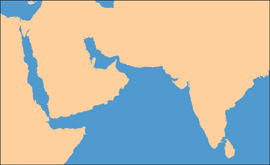|
Eastward Trade
The shipment of cullet to regions at the fringes
of the Empire that generally lacked the usual glass ingredients,
and/or an experience in making it, was a quite viable commercial
concern. In the 2nd century A.D. manuscript, Periplus Maris Erythraei, cargoes which include loads of raw glass among a host of far more
expensive goods such as Italian wine and tin, are documented as
being exchanged at markets in several Indian Ocean ports for valuable
perfume ingredients such as costus and nard, and for other oriental
exotics such as Chinese silk and onyx.
Cullet could be packed tightly and with little
concern about further breakage, so it probably was used quite often
as a shipping ballast. The only load of this kind thus far recovered,
however, is post-Romanšone weighing some three metric tons
in the hold of an 11th century A.D. shipwreck, where the main cargo
was wine amphorae.
|
|

Click on map for larger version |

